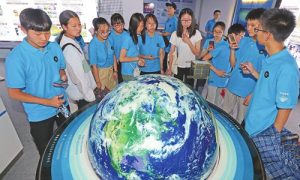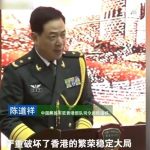Increased investment in education shows growing spending power in China
More and more middle-income Chinese parents are increasing investment in their children’s education, as many of them support their kids taking part in global study tours during the summer vacation, despite high costs.
Charles Chen, a freshman in a university in East China’s Jiangsu Province, is spending his summer vacation in New Zealand.
“Living with a homestay family, I go to a local school every day to take English language courses,” Chen told the Global Times over the weekend.
“There are many other Chinese students like me taking short-term study tours in Auckland. It is not like traveling abroad during my previous holidays; Study trips offer me a chance to get closer to local customs, culture and people, and also help me improve English and independent life skills, which is meaningful,” he said.
The program, which lasts eight weeks, costs around 42,000 yuan ($6,107), Chen said.
Rising demand
Consisting of language classes, summer camps, university programs, sightseeing and global communication, overseas study trips enjoy increasing popularity among Chinese students and their parents.
The number of students going abroad for study tours will reach nearly 12,500 during this summer vacation, said Liu Ting, CEO of Walkite International Education & Travel Co of Beijing New Oriental.
Since 2005, the company has been providing Chinese students the opportunity to combine their passion for education with travel, for students of various ages.
About a decade ago, Chinese first-tier cities including Beijing, Shanghai, Shenzhen and Guangzhou, South China’s Guangdong Province, had a significant number of parents send their children on summer study trips in overseas countries, Liu told the Global Times on Friday.
More recently the trend is extending to parents in second, third and fourth-tier cities as they are placing such study trips on their children’s agendas during summer vacations, Liu said.
Apart from New Oriental, plenty of English training institutions and travel agencies across the country are also devoted to organizing overseas study tours.
“Over the past three years, we have seen the number of students going abroad for study tours increase by nearly 50 percent each year. There are about 100 groups with more than 10,000 students who will go on summer study programs to overseas destinations through Ctrip,” Yao Zhao, director of the Global Study Tour unit of the firm, China’s leading online travel agency, told the Global Times.
Overseas trips cost between 35,000 yuan to 50,000 yuan, according to choice of destination and forms of activities included, Yao said.
Chinese parents are attaching great importance to improving the overall quality of their children’s lives, and there has been rising demand from domestic parents and students for a productive vacation through various extracurricular activities, Liu said.
More and more Chinese parents are willing to and capable of increasing investment in education for their children, although such programs are not cheap, Yao said, noting that the domestic market scale of global study trips will reach nearly 200 billion yuan in the next three years.
English-speaking countries like the US, the UK, Australia, Canada and some other European countries were among the top destinations for Chinese students, Liu said.
Due to factors such as ongoing trade tensions between China and the US, study tours to America have entered a cooling-off period, Liu said, also noting that Chinese parents were affected. They worry for the safety of their children in the US given the current unstable bilateral relations between the two countries.
Yao, who observed a similar situation on Ctrip, attributed the cooling-off of US tours to the increasing difficulty of acquiring an American visa.
Other destinations in Asia such as Singapore and Thailand are getting popular, Yao said.
Increased spending
Apart from overseas study tours, tutorial classes focusing on school subjects and interesting, nurturing courses such as learning musical instruments and sports are also welcomed during the summer vacation.
 A group of students visit Zhejiang University during a summer camp in Hangzhou, East China’s Zhejiang Province on July 9. Photo: VCG
A group of students visit Zhejiang University during a summer camp in Hangzhou, East China’s Zhejiang Province on July 9. Photo: VCG
“In a bid to help my daughter better prepare for her high school studies this September, I signed her up for tutorial classes in August,” Li Jin, a parent based in Xi’an, capital of Northwest China’s Shaanxi Province, told the Global Times on Thursday.
“The 10-day course will focus on four subjects including math, physics, chemistry and biology, and costs around 3,000 yuan,” Li said.
“Most of my daughter’s friends choose to travel and take such tutorial lessons this summer. I also plan to take her to Shanghai Disneyland to relax later,” she said.
A father surnamed Du in the fourth-tier city of Zunyi, Southwest China’s Guizhou Province, told the Global Times that “I will take my son, who just graduated from middle school, to visit Beijing this summer.”
“My son hasn’t visited the capital yet and I hope the trip will help broaden his horizons,” Du said.
“Transportation, a hotel, food and tickets will altogether cost around 20,000 yuan for a seven-day trip,” the father said, noting that although the expense is not cheap, it is “necessary.”
A dozen parents told the Global Times that the Chinese education market now offers multiple choices for children and parents as the country’s ongoing consumption upgrade has made it imperative for educational agencies to improve the quality of their services.
Thanks to the increase in domestic personal income during recent years, parents will have higher budgets for education investment, Yao said.
“For instance, only high-income families could afford to or were willing to choose our products such as tour trips to the UK, which cost 35,000 yuan to 50,000 yuan, at the very beginning when we started five years ago,” Yao said.
“But we gradually found that more and more consumers are average-income families,” he said.
In the first half of 2019, China’s per capita disposable personal income rose 6.5 percent year-on-year in real terms to 15,294 yuan, according to data released by the National Bureau of Statistics (NBS) on Monday.
More than 60 percent of parents among 60 families surveyed in Beijing said their average spending on children’s summer courses ranged between 5,000 to 30,000 yuan, according to a report released by people.cn over the weekend.
A total of 35.48 percent of surveyed families will spend between 3,000 yuan to 5,000 yuan during summer vacations, 27.42 percent will spend 10,000 to 30,000 yuan and 9.68 percent will spend more than 30,000 yuan, said the report.
Economy driver
Domestic families’ increased spending in education during summer vacations is one of the phenomena that showed the strong spending power of China’s middle-class as the country is undergoing a consumption upgrade, Wu Hao, a Shenzhen-based industry observer, told the Global Times over the weekend.
“Not only in the education sector, Chinese people have been spending in an ever-growing pace in sectors like entertainment, culture, transportation, healthcare and tourism over recent years,” Wu said, noting that their spending demand has gradually grown to a higher level from one that paid food and clothing bills in previous decades.
The stable growth of domestic spending power plays a key role in bolstering the economic development of China, given that China faced uncertainties from an unstable global economic climate and trade tensions with the US, according to Wu.
Consumer spending contributed 76.2 percent to China’s GDP in 2018, up 18.6 percentage points over the previous year, making it the largest driving force of the country’s economic growth for six years in a row, according to the NBS.
Industry insiders said the trend is expected to continue with a slew of government support measures, such as individual income tax cuts and preferential policies for the purchase of new-energy vehicles.
The threshold for individual income tax was raised in October last year, as six special, additional deductions were created, including one for children’s education. This benefits approximately 80 million taxpayers, Xinhua said.
Industry insiders said that the digital economy has largely affected traditional consumption in China. Fast development of technology in China including the mobile internet, big data and artificial intelligence will continue to prompt new consumption growth points in the Chinese market.
Also, Chinese people’s improved consumption concepts, from “saving for spending” to “borrowing for consuming,” will continue to stimulate domestic consumption.




